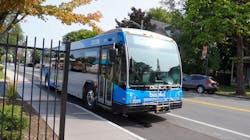CDTA tests antimicrobial spray, air-sanitizing technology
Capital District Transportation Authority (CDTA) began installation of air sanitizing technology in February following an eight-month pilot period and continues to monitor developments regarding cleaning protocols as it continues to focus on providing riders and employees a safe environment.
CDTA has collected eight months of testing data validating the effectiveness of surface and air-cleaning technologies. Beginning in August 2020, two 40-foot GILLIG diesel hybrid buses were used as testbeds for evaluation of two products made by the United Safety and Survivability Corporation (United Safety).
United Safety products used in the testing were an antimicrobial spray and an air-sanitizing PHI Cell® technology by RGF that utilizes broad spectrum UV-C light and catalyst in a process generating the release of low-level hydrogen peroxide into the air. The antimicrobial spray was tested for a three-month period, while the air-cleaning technology was tested from August 2020 to February 2021. Tested areas were frequently touched areas of the buses, including driver area and steering wheel, doors, handrails, seatbelts, backs and tops of seats and upper deck stanchions.
Third-party adenosine triphosphate (ATP) testing swabs were used for the data collection. ATP is the industry standard for detecting pathogens since only living organisms can produce the organic compounds. Measured areas were found to be at the two highest ATP levels of cleanliness – ultra (equivalent to a hospital’s sterile level of cleanliness) and very clean (food-handling level of cleanliness).
“We have tested the United Safety technology for an extended period and have found it to be effective in continuously reducing surface and airborne pathogens inside the bus,” said CDTA Vice President of Operations Lance Zarcone. “This technology will help us to further improve air and surface cleanliness and is aligned with our mission of transporting people safely and reliably.”
GILLIG offers United Safety sanitization and other company cleaning products to bus customers across the nation.
“We offer a suite of health-safety protection devices and products to our customers,” said GILLIG Vice President of Sales Bill Fay. “The Albany test was further validation of the ability of these United Safety technologies to protect bus riders from pathogens. GILLIG has implemented several measures over the past year to protect drivers and riders of our buses, including working with partner agencies to design and retrofit 2,500 buses with driver protection barriers.”
GILLIG is now offering customers five different driver barrier protection options for buses, two different air-intake systems for new buses and retrofits, a wheelchair securing system, as well as making available new cleanable passenger grab-handles and safety straps for riders. One of the air-intake systems works through the driver’s heater, while the second is installed in the air conditioning of a bus and designed to draw in fresh air from the outside. In addition, GILLIG is exploring new safety and protection technologies through research and development, including for the company’s newest market entrant, the zero-emission battery electric bus.
